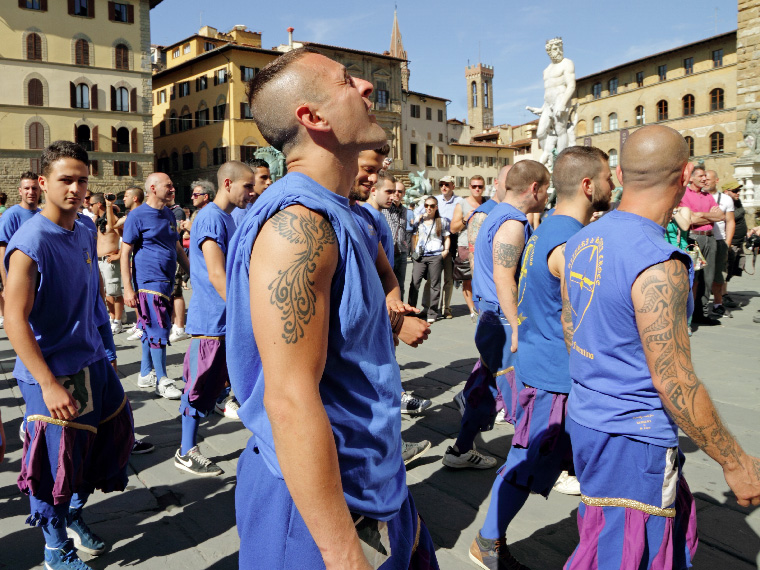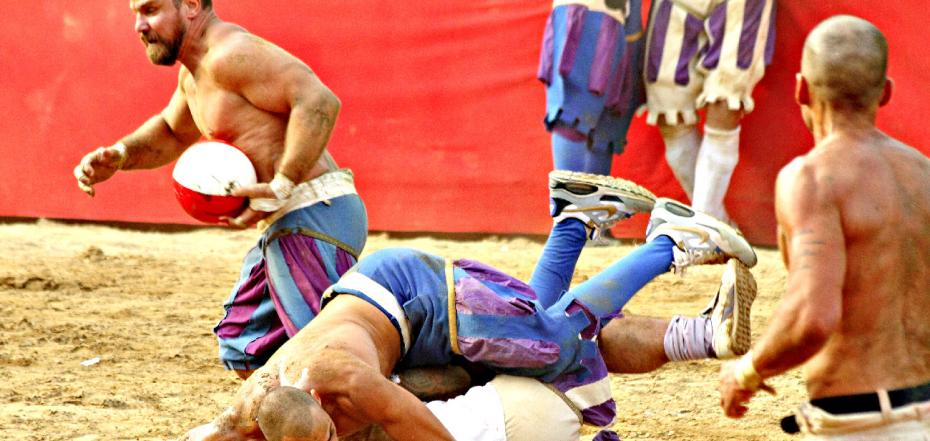In 16th century Italy, Italians played a sport called Calcio Fiorentino. It is an extremely violent game, and combines elements of soccer, rugby and bare-knuckle fighting into one brutal and bloody event. Some history books say it was played by rich aristocrats, and sometimes even Popes, Clement VII, Leo XI and Urban VIII were said to be particularly fond of the game and often joined in. I find that hard to believe.
After all, rich aristocrats and Popes didn’t even dress themselves in those days, so it’s difficult to imagine them jumping into the middle of such a bloody and brutal sport. And by the time the Popes were elected Pope, they were old and kind of on the chubby side and well, you be the judge. Does this seem to be a sport for chubby, old men?
The truth is Calcio Fiorentino is a blood sport and because it is such a brutal game, the Italians stopped playing it sometime around the 17th century. But then, in 1930, a group of Florentines decided to revive it.

Traditionally Calcio Fiorentino, or calcio storico (historic football), is played on a sand field that is twice as long as it is wide. At each end, there is a net goal that stretches the width of the field.
There are 27 men from each team, and they are all on the field at the same time. That means there are 54 men knocking the bejeebers out of each other for 50 full minutes, which is how long the game lasts. When the 50 minutes of insane brutality are over, whichever team scored the most points wins.
To score a goal, which is called a caccia, players have to put the ball into the opponents’ net. Easier said than done as all the while you are trying to put the ball in the other teams net, they are hard at work beating you about the head and shoulders. And don’t take a shot for the goal unless you know you are going to make it because if you miss, the other team gets half a caccia.
There are other rules, of course. Kicking, punching, head-butting and choking are all allowed, but you’ll get booted out of the game if you are caught throwing a sucker punch or kicking an opponent in the head. Biting the ears off of your opponent is not encouraged either, nor is ganging up on one player.
While there are referees on the field, you can spot them by their spiffy red and white pantaloons, but they only get involved if a fight or brawl breaks out. While you can smash the bejeebers out of your opponent when you are trying to score a caccia, you can’t just beat them into the ground and continue to do so without a referee coming over and chastising you. After all, the object of the game is to put the ball in the net, not kill the people you’re playing against.
There’s no way of telling if those rules always applied, especially back in the day when the Greeks ran things. They played a version of this game that they called Sfermomachia. The game was later adopted by the Roman army and transformed into a type of warrior training. The Romans called it Harpastum, which in Latin literally means to rip off – like rip off your head.
The Romans loved the continuous body-to-body, head to head combat for possession of the ball, it brought out their inner gladiator and it was through their love of the game that it spread throughout the Roman Empire.
For all we know the Romans could have been playing calcio Fiorentino back in 59 A.D. when they founded the city of Fiorenza, now known as Florence. Anything is possible. One thing we do know is that by the second half of the 5th century, calcio was so popular among young Florentines that they often played it in the streets and squares of the city. And one winter, back in 1490 when the Arno River was completely frozen over, they marked off a field and played a few games on the ice.
The game is now played in Florence as a tournament during the 3rd week of June. Florence is divided into quadrants and each quadrant provides one team to play. After two opening games, the two remaining teams play in the final. The championship game is played on June 24th, which is San Giovanni (St. John’s Day), San Giovanni being the Patron Saint of Florence.
Each team fights its hardest to win the grand prize, a cow! Not just any cow, but a Chianina cow which is one of the largest cattle in the world, and also one of the oldest in existence. Their meat is delicious and the best cut is used for bistecca alla Fiorentina, a massive T-bone steak.
What better way to celebrate a win than to fire up the grill and share a steak dinner with your teammates and their families. Laugh if you want, but the Italians know what they are doing, after all, a shiny metal Winner’s Cup isn’t very tasty, now it is.
Phyllis Macchioni is a Italian American writer who lives on the Italian Riviera. She is the author of a recently published collection of essays entitled “This Italian Life – People and Places”, available on Amazon. Visit her blog at https://www.thisitalianlife.blogspot.com or follow her at https://www.facebook.com/phyllis.macchioni Email:phyllisinitaly@ gmail.com.
Twitter: @phyllisinitaly



























